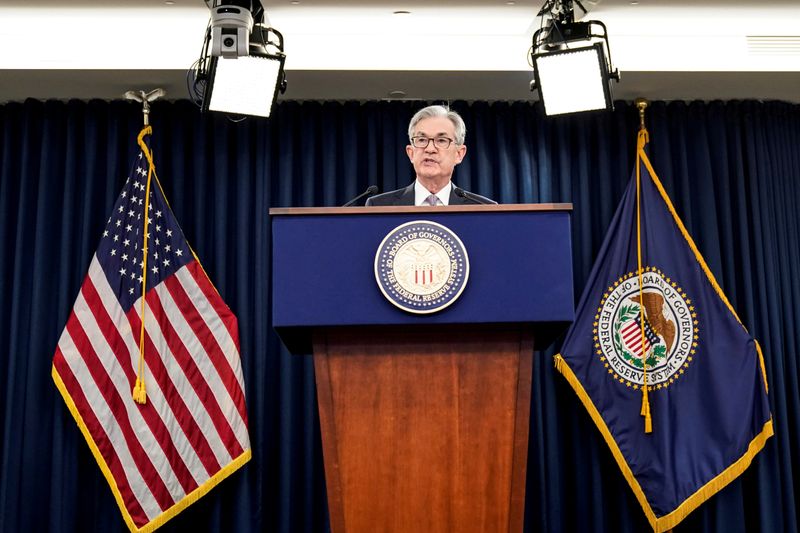(Reuters) – Federal Reserve policymakers are expected this week to forecast that the U.S. economy will grow in 2021 at the fastest rate in decades, with unemployment falling and inflation rising, as the COVID-19 vaccination campaign gathers pace and a $1.9 trillion relief package washes through to households.
But investors who expect rosier projections to translate to any change in monetary policy when the U.S. central bank’s Federal Open Market Committee ends its two-day meeting on Wednesday will likely be disappointed.
“The FOMC will not validate market expectations of an earlier and faster liftoff and will reiterate that its policy stance will remain very dovish for the foreseeable future,” Cornerstone Macro economist Roberto Perli told clients in a note last week.
“Bottom line, don’t expect the FOMC’s tone to change much.”
The Fed has kept interest rates pinned near zero for the past year, and has promised to keep them there until the economy reaches full employment, and inflation has hit 2% and is on track to exceed that pace for some time.
That’s a higher bar for raising rates than it set in the past. With inflation falling short of the Fed’s target in recent years even when unemployment was very low, the central bank flipped its policy approach last year, pledging under a new framework to no longer act preemptively to head off inflation, and to aim for broad-based and “inclusive” full employment.
It is also buying $120 billion in Treasuries and mortgage-backed securities and has said it will keep doing so until it sees “substantial further progress” toward its full employment and inflation goals.
In recent weeks, Fed Chair Powell has said he expects faster economic growth this year to push unemployment down and prices up as newly vaccinated people dine out, book travel and undertake other long-deferred activities.
But Powell doesn’t expect price increases driven by the coming spending surge to be long-lasting or even terribly big, and plans to be “patient” when it comes to changing the Fed’s bond-buying program.
Powell and other Fed officials have said they believe the current 6.2% unemployment rate vastly understates the weakness of the labor market in part because it does not take into account the millions of people who have stopped looking for jobs.
While fresh Fed forecasts will likely pencil in a fall in unemployment this year to well below the 5% projected three months ago, that decline could mask both a large number of workers on the sidelines and higher unemployment among groups hardest hit by the pandemic-triggered recession, including Blacks, Latinos and women.
“They’ve made it very clear that they don’t think ‘substantial further progress’ has been made yet and think it will take some time to do so,” said Zachary Griffiths, a macro strategist for Wells Fargo Securities.
LOOKING TOWARD JUNE?
Since the U.S. central bank last provided economic forecasts in December, Congress has passed two new aid packages totaling about $2.8 trillion – the equivalent of about 15% of annual U.S. economic output.
Given that expected influx of cash, a COVID-19 vaccination program recently averaging more than 2 million shots a day, and increasing numbers of state governors relaxing restrictions on activity, Fed officials are widely expected to bump up their forecasts for economic growth this year to perhaps 6% or more, from the 4.2% projected in December. Anything over 5% would be the fastest annual pace since 1984, when the economy grew 7.2%.
A few analysts say that will mean a majority of the Fed’s 18 policymakers will forecast an interest rate hike by 2023.
The so-called “dot plot” of rate hike expectations issued in December showed just five expecting rates to rise by then.
It’s a “close call,” Nomura economists wrote in a note last week, but with unemployment expected to fall and Fed policymakers likely to see inflation rising to 2.1% in 2023, “many participants will view the Fed’s three criteria for liftoff as met by mid-2023.”
Traders in interest rate futures are pricing in a much more aggressive scenario, with liftoff occurring in late 2022 and two additional quarter-percentage-point hikes in 2023.
Longer-term borrowing costs have also risen, with 10-year Treasury yields now around 1.6%, up from less than 1% just three months ago, as investors price in stronger economic growth and, perhaps, higher inflation. But unlike the European Central Bank, which last week said it would accelerate its bond purchases to keep rising yields from derailing the economic recovery there, the Fed has signaled little discomfort with the market moves.
“I do worry that (new Fed forecasts point to) a rate hike in 2023 and considerably stronger growth this year and higher inflation this year and the markets misunderstand and say ‘they are going to bail on their forward guidance and they are going to raise rates soon,'” said William English, a Yale School of Management professor and former head of the Fed’s monetary affairs division. The Fed would have to “get in front of that,” he added.
Still, most analysts expect the majority of forecasts to continue to signal no rate hikes through the end of 2023.
The stakes are high, said Tim Duy, an economics professor at the University of Oregon, as Fed policymakers aim “to anchor the credibility of their profoundly changed framework against a coming cascade of strong growth and potentially higher inflation.”
But sticking to a dovish tone now may ultimately raises the odds of bringing the current recession, and the current period of super-easy Fed policy, to an earlier end.
As the year progresses, “interest rate hike expectations will be increasingly difficult for the Fed to downplay,” says James Knightley, an economist at ING.
But that isn’t necessarily a bad thing if, say by June, a majority of Fed policymakers do see a 2023 liftoff, he said. “Getting that normalization earlier would be success for the Fed.”
(Additional reporting by Jonnelle Marte and Howard Schneider; Editing by Dan Burns and Paul Simao)























